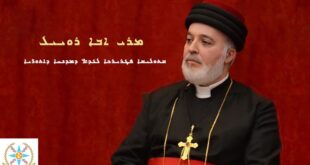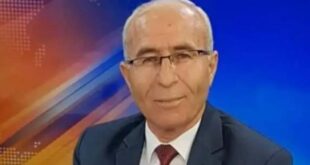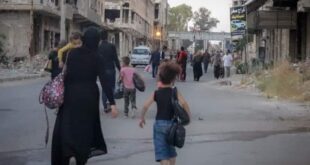By Barbara Karkabi *
Syrie – AINA — The 20th century was not kind to the Orthodox archdiocese in southern Syria. Ravaged by war, drought and poverty, its ancient churches were left to crumble, while the Christian population dwindled.
But in 1999 a new archbishop was appointed as metropolitan of the Antiochian Orthodox Christian Archdiocese of Bosra, Hauran, Jabal Arab and Golan in Syria. Determined to live in the archdiocese, unlike his predecessors, Metropolitan Saba set about revitalizing the historically significant area and began by restoring the dilapidated chancery in Sweida in southeast Syria. He visited Houston recently to meet with friends and financial supporters at St. George Antiochian Orthodox Christian Church.
Sayedna, as he is affectionately called in Arabic, updated parishioners on conditions in the diocese and showed a video including sites from Greek and Roman times and of three ancient churches. “We use all three, but they need so much renovation,” Metropolitan Saba said. “St. George of Izraa was built in 515, St. Elias may be from the fourth century.” The third, St. George of Kharaba, is from the eighth century, he said.
St. Elias has been restored, thanks to the generosity of a Syrian-American whose family came from the area. But St. George of Izraa, built on the site of a pagan temple, is in need of extensive renovation, he said. Legend has it that until the 11th century, it contained the relics of St. George the Martyr. “Many miracles were done by St. George in the church,” he said. “It’s deeply venerated by Christians, Muslims and Druze. Some Muslims come to the church and light candles.” When Metropolitan Saba arrived in 1999, only three priests were working in the area.
Two were more than 80 years old and have since died; the other was in his 70s. None was properly trained. After years of looting, only one icon of St. George was left in the ancient churches. Money eventually will be raised for more icons, but the archbishop’s first concern was to help the people who had been neglected for so long. About 1 million to 2 million Christians of different denominations live in Syria. Twenty thousand Antiochian Orthodox Christians live in the southern archdiocese, while another 125,000 work in Damascus or other cities and return on weekends.
“Sayedna thought he could work it out and make it viable,” said the Rev. John Salem of Houston’s St. George Antiochian Orthodox Christian Church. “He wanted to give them hope. The people deserve to be served, especially because of the historical significance of the archdiocese.” Because of Syria’s close proximity to the birthplace of Christianity, the religion spread quickly in what has been considered a historical crossroads for many empires. St. Paul visited after his conversion. And St. Timon, appointed as one of 70 Apostles (after the original 12), was the first bishop of Bosra.
Yet the Christians in the archdiocese were without pastoral help for years. Those who remained slipped into poverty, and less money was given to the church. “So many generations lived without Christian education, liturgy and without any humanitarian help from the church,” Metropolitan Saba said. “Yes, I have worked very hard, but God is with us.” After the chancery was restored, the metropolitan had a place to live. Next he recruited young priests and sent them to seminary.
Eight priests, most in their 30s, now serve 32 churches in the archdiocese. A guesthouse was built to encourage people from Syria, Lebanon and Jordan to visit and form relationships with the local Christians. Metropolitan Saba also bought a small piece of land and planted it with olive and fig trees, blackberry bushes and grapes. Each year, he buys a little more land and increases the crop. The archdiocese currently helps feed 192 families a month, “the poorest of the poor” Christians, Muslims and Druze.
“They see that we help them,” he said. “It’s the Christian message: ‘I was hungry and you fed me.’ ” Because of that, people of many religions know of the metropolitan’s work and have made donations, Salem said. “Thank God and they trusted me,” Metropolitan Saba said. “With the help of the Orthodox Church of Greece, we built a small medical center. It’s very modern, but with primitive equipment, so we need more to treat the poor people.
The more I have, the more I do — small projects to get more income.” He has started coffee hours after church and women’s fellowship groups to distribute food and visit the sick. Soon he hopes another women’s fellowship will visit the elderly. Sunday-school education is now provided for 80 percent of the children, and he strives to create a family atmosphere. The secular government of Syria has provided some funds to restore the ancient churches. And finally the Friends of the Church of St.
George, Izraa, is actively working to raise money for restoration. The dome of St. George of Izraa was destroyed by an earthquake in 1899. It was replaced by Tsar Nicholas II of Russia in 1912 but needs repair. The church, two octagons in a square, was built of black basalt, a stone indigenous to the area. Windows at the base of the dome create natural light. Scholars consider it the first example of a square type of church.
The purpose of the metropolitan’s monthlong trip to the U.S. was to visit with friends, not to raise funds, Salem said. “But everyone loves him and knows the work he is doing, so people wanted to help him,” the Houston priest said. “I think really because he is just so humble and kind to everyone. And he is doing the work we are called to do: feed the hungry and give drink to the thirsty.”
* By Barbara Karkabi
Houston Chronicle
 Assyrian Democratic Organization ADO
Assyrian Democratic Organization ADO






